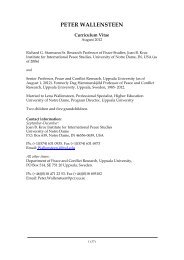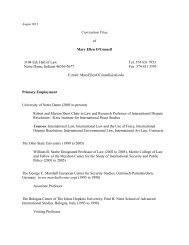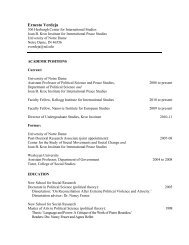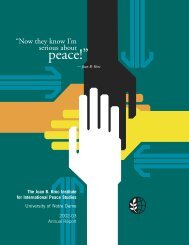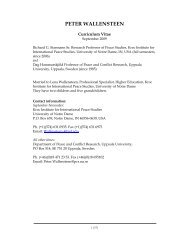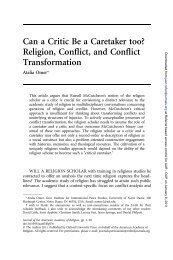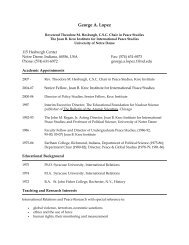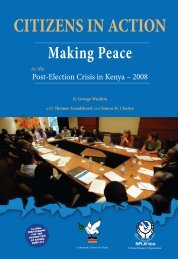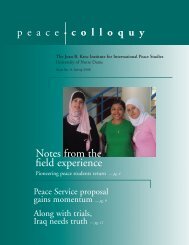Somalia: Creating Space for Fresh Approaches to Peacebuilding
Somalia: Creating Space for Fresh Approaches to Peacebuilding
Somalia: Creating Space for Fresh Approaches to Peacebuilding
You also want an ePaper? Increase the reach of your titles
YUMPU automatically turns print PDFs into web optimized ePapers that Google loves.
impact of international media in somalia<br />
Media and humanitarian/military interventions<br />
After the first Gulf War in 1991 and the UN/US interventions in <strong>Somalia</strong> between<br />
1992 and 1994, the predominant school of thought was that there was a “CNNeffect”<br />
that influenced a government’s decision <strong>to</strong> both intervene in and exit a<br />
conflict. 1 The CNN-effect refers <strong>to</strong> the speed and volume of media in the late 20 th<br />
and early 21 st centuries that brings the suffering of people around the world in<strong>to</strong><br />
Western homes through their televisions screens, computers, and newspapers.<br />
This coverage by Western media outlets, from CNN <strong>to</strong> the New York Times and<br />
the BBC, puts pressure on government officials <strong>to</strong> take action <strong>to</strong> end the violence<br />
and suffering being shown on the news, even if intervening does not further a<br />
government’s <strong>for</strong>eign policy interests. 2<br />
Extensive studies of the CNN-effect have been conducted with regard <strong>to</strong> the<br />
US intervention in <strong>Somalia</strong> in 1992. The most compelling evidence of the effect<br />
comes from a statement <strong>for</strong>mer President George H.W. Bush made concerning<br />
his decision <strong>to</strong> intervene:<br />
Former President Bush conceded Saturday that he ordered US troops in<strong>to</strong> <strong>Somalia</strong><br />
in 1992 after seeing heart-rending pictures of starving waifs on television … Bush<br />
said that as he and his wife, Barbara, watched television at the White House and<br />
saw “those starving kids … in quest of a little pitiful cup of rice”, he phoned Defense<br />
Secretary Dick Cheney and General Colin Powell, chairman of the Joint Chiefs of Staff.<br />
“Please come over <strong>to</strong> the White House”, Bush recalled telling the military leaders. “I –<br />
we – can’t watch this anymore. You’ve got <strong>to</strong> do something.” 3<br />
Similarly, the deaths of eighteen US soldiers during a Mogadishu battle and the<br />
television images of their bodies being dragged through the streets is commonly<br />
believed <strong>to</strong> have precipitated America’s hurried withdrawal from <strong>Somalia</strong>. 4<br />
However, more recent research has shown that the CNN-effect is not as powerful<br />
as once believed. An alternative theory of media impact is that of Manufacturing<br />
Consent. This literature posits that the government guides media coverage in<br />
accordance with its own interests and agenda, as opposed <strong>to</strong> the media guiding<br />
governmental policy. 5 Within the <strong>Somalia</strong> intervention example, proponents of<br />
this theory claim that the government was already leaning <strong>to</strong>wards involvement,<br />
and the media simply converged with this likely policy outcome. 6<br />
Piers Robinson attempts <strong>to</strong> integrate these two theories with his policy-media<br />
interaction model. This model proposes that when the government’s policy has<br />
already been set, the media tends <strong>to</strong> con<strong>for</strong>m <strong>to</strong> it, and there<strong>for</strong>e has no independent<br />
influence on <strong>for</strong>eign policy <strong>to</strong>wards a particular conflict. However, in<br />
cases where either members of the government are divided concerning the best<br />
policy, or when the policy is uncertain, the media will reflect those debates, and<br />
has an opportunity <strong>to</strong> influence the decision <strong>to</strong> choose one policy over another. 7<br />
When using this model <strong>to</strong> determine the media’s impact on peacebuilding ef<strong>for</strong>ts,<br />
it is important <strong>to</strong> analyze how the media is framing the conflict:<br />
To frame is <strong>to</strong> select some aspects of a perceived reality and make them more salient<br />
in a communicating text, in such a way as <strong>to</strong> promote a particular problem definition,<br />
causal interpretation, moral evaluation, and/or treatment recommendation. 8<br />
1 Robinson, Piers, “The CNN<br />
Effect: Can the News Media<br />
Drive Foreign Policy?” Review of<br />
International Studies, 25 (1999):<br />
p. 302.<br />
2 Spencer, Graham, The Media and<br />
Peace: From Vietnam <strong>to</strong> the ‘War on<br />
Terror’, (New York, NY: Palgrave<br />
Macmillan: 2005): pp. 24-25.<br />
3 Hines, Craig, “Pity, not US<br />
Security, Motivated US of GIs in<br />
<strong>Somalia</strong>, Bush Says”, The Hous<strong>to</strong>n<br />
Chronicle, 24 Oc<strong>to</strong>ber 1999: A11.<br />
4 Hammond, Philip, Framing<br />
Post-Cold War Conflicts: The Media<br />
and International Intervention, (New<br />
York, NY: Manchester University<br />
Press, 2007).<br />
5 Robinson, “The CNN Effect”: pp.<br />
303-304.<br />
6 Robinson, “The CNN Effect”:<br />
p. 307.<br />
7 Robinson, Piers, “Theorizing<br />
the Influence of Media on World<br />
Politics: Models of Media Influence<br />
on Foreign Policy”, European<br />
Journal of Communication, 16, 4<br />
(2001): p. 531<br />
8 Entman, Robert, “Framing:<br />
Towards Clarification of a<br />
Fractured Paradigm”, Journal of<br />
Communication, 43, 4 (1993): p. 52,<br />
original emphasis.<br />
53



